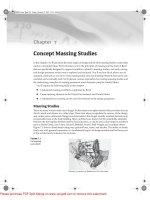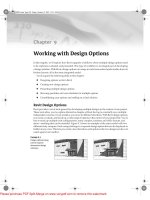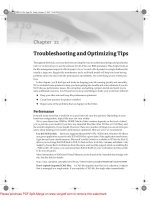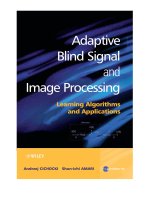Tài liệu Advance computer architecture and parallel processing pptx
Bạn đang xem bản rút gọn của tài liệu. Xem và tải ngay bản đầy đủ của tài liệu tại đây (4.2 MB, 288 trang )
TeAM
YYeP
G
Digitally signed by
TeAM YYePG
DN: cn=TeAM YYePG,
c=US, o=TeAM YYePG,
ou=TeAM YYePG,
email=
Reason: I attest to the
accuracy and integrity
of this document
Date: 2005.05.03
22:10:22 +08'00'
ADVANCED COMPUTER ARCHITECTURE
AND PARALLEL PROCESSING
WILEY SERIES ON PARALLEL AND DISTRIBUTED COMPUTING
SERIES EDITOR: Alber t Y. Zomaya
Parallel & Distributed Simu lation Systems / Richard Fujimoto
Surviving the Design of Microprocessor and Multimicroprocessor Systems:
Lessons Learned / Veljko Milutinovic
Mobile Processing in Distributed and Open Environments / Peter Sapaty
Introduction to Parallel Algorithms / C. Xavier and S.S. Iyengar
Solutions to Parallel and Distributed Computing Problems: Lessons from
Biological Sciences / Albert Y. Zomaya, Fikret Ercal, and Stephan Olariu (Editors)
New Parallel Algorithms for Direct Solution of Linear Equations /
C. Siva Ram Murthy, K.N. Balasubramanya Murthy, and Srinivas Aluru
Practical PRAM Programming / Joerg Keller, Christoph Kessler, and Jesper
Larsson Traeff
Computational Collective Intelligence / Tadeusz M. Szuba
Parallel & Distributed Computing: A Survey of Models, Paradigms, and
Approaches / Claudia Leopold
Fundamentals of Distributed Object Systems: A CORBA Perspective / Zahir
Tari and Omran Bukhres
Pipelined Processor Farms: Structured Design for Embedded Parallel
Systems / Martin Fleury and Andrew Downton
Handbook of Wireless Networks and Mobile Computing / Ivan Stojmenoviic
(Editor)
Internet-Based Workfl ow Management: Toward a Semantic Web /
Dan C. Marinescu
Parallel Computing on Heterogeneous Networks / Alexey L. Lastovetsky
Tools and Environments for Parallel and Distributed Computing Tools /
Salim Hariri and Manish Parashar
Distributed Computing: Fundamentals, Simulations and Advanced Topics,
Second Edition / Hagit Attiya and Jennifer Welch
Smart Environments: Technology, Protocols and Applications /
Diane J. Cook and Sajal K. Das (Editors)
Fundamentals of Compu ter Organization and Architecture / Mostafa Abd-El-
Barr and Hesham El-Rewini
Advanced Computer Architecture and Parallel Processing / Hesham El-Rewini
and Mostafa Abd-El-Barr
ADVANCED COMPUTER
ARCHITECTURE AND
PARALLEL PROCESSING
Hesham El-Rewini
Southern Methodist Universi ty
Mostafa Abd-El-Barr
Kuwait University
A JOHN WILEY & SONS, INC PUBLICATION
This book is printed on acid-free paper.
1
Copyright # 2005 by John Wiley & Sons, Inc. All rights reserved.
Published by John Wiley & Sons, Inc., Hoboken, New Jersey.
Published simultaneously in Canada.
No part of this publication may be reproduced, stored in a retrieval system, or transmitted in any form or
by any means, electronic, mechanical, photocopying, recording, scanning, or otherwise, except as
permitted under Section 107 or 108 of the 1976 United States Copyright Act, without either the prior
written permission of the Publisher, or authorization through payment of the appropriate per-copy
fee to the Copyright Clearance Center, Inc., 222 Rosewood Drive, Danvers, MA 01923,
for permission should be addressed to the Permissions Department, John Wiley & Sons, Inc.,
111 River Street, Hoboken, NJ 07030, (201) 748-6011, fax (201) 748-6008.
Limit of Liability/Disclaimer of Warranty: While the publisher and author have used their best efforts
in preparing this book, they make no representations or warranties with respect to the accuracy or
completeness of the contents of this book and specifically disclaim any implied warranties of
merchantability or fitness for a particular purpose. No warranty may be created or extended by sales
representatives or written sales materials. The advice and strategies contained herein may not be
suitable for your situation. You should consult with a professional where appropriate. Neither the
publisher nor author shall be liable for any loss of profit or any other commercial damages, including
but not limited to special, incidental, consequential, or other damages.
For general information on our other products and services please contact our Customer Care Department
within the U.S. at 877-762-2974, outside the U.S. at 317-572-3993 or fax 317-572-4002.
Wiley also publishes its books in a variety of electronic formats. Some content that appears in print,
however, may not be available in electronic format.
Library of Congress Cataloging-in-Publication Data is available
ISBN 0-471-46740-5
Printed in the United States of America
10987654321
978-750-8400, fax 978-646-8600, or on the web at www.copyright.com. Requests to the Publisher
To the memory of Abdel Wahab Motawe, who wiped away the tears of many people and
cheered them up even when he was in immense pain. His inspiration and impact on my life and
the lives of many others was enormous.
—Hesham El-Rewini
To my family members (Ebtesam, Muhammad, Abd-El-Rahman, Ibrahim, and Mai)
for their support and love
—Mostafa Abd-El-Barr
&
CONTENTS
1. Introduction to Advanced Computer Architecture
and Parallel Processing 1
1.1 Four Decades of Computing 2
1.2 Flynn’s Taxonomy of Computer Architecture 4
1.3 SIMD Architecture 5
1.4 MIMD Architecture 6
1.5 Interconnection Networks 11
1.6 Chapter Summary 15
Problems 16
References 17
2. Multiprocessors Interconnection Networks 19
2.1 Interconnection Networks Taxonomy 19
2.2 Bus-Based Dynamic Interconnection Networks 20
2.3 Switch-Based Interconnection Networks 24
2.4 Static Interconnection Networks 33
2.5 Analysis and Performance Metrics 41
2.6 Chapter Summary 45
Problems 46
References 48
3. Performance Analysis of Multiprocessor Architecture 51
3.1 Computational Models 51
3.2 An Argument for Parallel Architectures 55
3.3 Interconnection Networks Performance Issues 58
3.4 Scalability of Parallel Architectures 63
3.5 Benchmark Performance 67
3.6 Chapter Summary 72
Problems 73
References 74
vii
4. Shared Memory Architecture 77
4.1 Classification of Shared Memory Systems 78
4.2 Bus-Based Symmetric Multiprocessors 80
4.3 Basic Cache Coherency Metho ds 81
4.4 Snooping Protocols 83
4.5 Directory Based Protocols 89
4.6 Shared Memory Programming 96
4.7 Chapter Summary 99
Problems 100
References 101
5. Message Passing Architecture 103
5.1 Introduction to Message Passing 103
5.2 Routing in Message Passing Networks 105
5.3 Switching Mechanisms in Message Passing 109
5.4 Message Passing Programming Models 114
5.5 Processor Support for Message Passing 117
5.6 Example Message Passing Architectures 118
5.7 Message Passing Versus Shared Memory Architectures 122
5.8 Chapter Summary 123
Problems 123
References 124
6. Abstract Models 127
6.1 The PRAM Model and Its Variations 127
6.2 Simulating Multiple Accesses on an EREW PRAM 129
6.3 Analysis of Parallel Algorithms 131
6.4 Computing Sum and All Sums 133
6.5 Matrix Multiplication 136
6.6 Sorting 139
6.7 Message Passing Model 140
6.8 Leader Election Problem 146
6.9 Leader Election in Synchronous Rings 147
6.10 Chapter Summary 154
Problems 154
References 155
7. Network Computing 157
7.1 Computer Networks Basics 158
7.2 Client/Server Systems 161
7.3 Clusters 166
7.4 Interconnection Networks 170
viii CONTENTS
7.5 Cluster Examples 175
7.6 Grid Computing 177
7.7 Chapter Summary 178
Problems 178
References 180
8. Parallel Programming in the Parallel Virtual Machine 181
8.1 PVM Environment and Application Structure 181
8.2 Task Creation 185
8.3 Task Groups 188
8.4 Communication Among Tasks 190
8.5 Task Synchronization 196
8.6 Reduction Operations 198
8.7 Work Assignment 200
8.8 Chapter Summary 201
Problems 202
References 203
9. Message Passing Interface (MPI) 205
9.1 Communicators 205
9.2 Virtual Topologies 209
9.3 Task Communication 213
9.4 Synchronization 217
9.5 Collective Operations 220
9.6 Task Creation 225
9.7 One-Sided Communication 228
9.8 Chapter Summary 231
Problems 231
References 233
10 Scheduling and Task Allocation 235
10.1 The Scheduling Problem 235
10.2 Scheduling DAGs without Considering Communication 238
10.3 Communication Models 242
10.4 Scheduling DAGs with Communication 244
10.5 The NP-Completeness of the Scheduli ng Problem 248
10.6 Heuristic Algorithms 250
10.7 Task Allocation 256
10.8 Scheduling in Heterogeneous Environments 262
Problems 263
References 264
Index 267
CONTENTS ix
&
PREFACE
Single processor supercomputers have achieved great speeds and have been pushing
hardware technology to the physical limit of chip manufacturing. But soon this trend
will come to an end, because there are physical and architectural bounds, which limit
the computational power that can be achieved with a single processor system. In this
book, we study advanced computer architectures that utilize parallelism via multiple
processing units. While parallel computing, in the form of internally linked
processors, was the main form of parallelism, advances in computer networks has
created a new type of parallelism in the form of networked autonomous computers.
Instead of putting everything in a single box and tightly couple processors to
memory, the Internet achieved a kind of parallelism by loosely connecting ever y-
thing outside of the box. To get the mos t out of a computer system with internal
or external parallelism, designers and software developers must understand the
interaction between hardware and software parts of the system. This is the reason
we wrote this book. We want the reader to understand the power and limitations
of multiprocessor systems. Our goal is to apprise the reader of both the beneficial
and challenging aspects of advanced architecture and parallelism. The material in
this book is organized in 10 chapters, as follows.
Chapter 1 is a survey of the field of computer architecture at an introductory level.
We first study the evolution of computing and the changes that have led to obtaining
high performance computing via parallelism. The popular Flynn’s taxonomy of
computer systems is provided. An introduction to single instruction multiple data
(SIMD) and multiple instruction multiple data (MIMD) systems is also given.
Both shared-memory and the message passing systems and their interconnection
networks are introduced.
Chapter 2 navigates through a number of system configurations for multi-
processors. It discusses the different topologies used for interconnecting multi-
processors. Taxonomy for interconnection networks based on their topology is
introduced. Dynamic and static interconnection schemes are also studied. The
bus, crossbar, and multi-stage topology are introduced as dynamic interconnections.
In the static interconnection scheme, three main mechanisms are covered. These are
the hypercube topology, mesh topology, and k-ary n-cube topology. A number of
performance aspects are introduced including cost, latency, diameter, node
degree, and symmetry.
Chapter 3 is about performance. How should we characterize the performance of
a computer system when, in effect, parallel computing redefines traditional
xi
measures such as million instructions per second (MIPS) and million floating-point
operations per second (MFLOPS)? New measures of performance, such as speedup,
are discussed. This chapter examines several versions of speedup, as well as other
performance measures and benchmarks.
Chapters 4 and 5 cover shared memory and message passing systems, respect-
ively. The main challenges of shared memory systems are performance degradation
due to contention and the cache coherence problems. Performance of shared
memory system becomes an issue when the interconnection network connecting
the processors to global memory becomes a bottleneck. Local caches are typically
used to alleviate the bottleneck problem. But scalability remains the main drawback
of shared memory system. The introdu ction of caches has created consistency
problem among caches and between memory and caches. In Chapter 4, we cover
several cache coherence protocols that can be categorized as either snoopy protocols
or directory based protocols. Since shared memory systems are difficult to scale up
to a large number of processors, message passing systems may be the only way to
efficiently achieve scalability. In Chapter 5, we discuss the arch itecture and the net-
work models of message passing systems. We shed some light on routing and net-
work switching techniques. We conclude with a contrast between shared memory
and message passing systems.
Chapter 6 covers abstract models, algorithms, and complexity anal ysis. We
discuss a shared-memory abstract model (PRAM), which can be used to study
parallel algorithms and evaluate their complexities. We also outline the basic
elements of a formal model of message passing systems under the synchronous
model. We design and discuss the complexity analysis of algorithms described in
terms of both models.
Chapters 7–10 discuss a number of issues related to network computing, in
which the nodes are stand-alone computers that may be connected via a switch,
local area network, or the Internet. Chapter 7 provides the basic concepts of
network computing including client/server paradigm, cluster computing, and grid
computing. Chapter 8 illustrates the parallel virtual machine (PVM) program ming
system. It shows how to write programs on a network of h eterogeneous machines.
Chapter 9 covers the message-passing interface (MPI) standard in which portable
distributed parallel programs can be developed. Chapter 10 addresses the problem
of allocating tasks to processing units. The scheduling problem in several of its
variations is covered. We survey a number of solutions to this important problem.
We cover program and system models, optimal algorithms, heuristic algorithms,
scheduling versus allocation techniques, and homogeneous versus heterogeneous
environments.
Students in Computer Engineering, Computer Science, and Electrical Engineer-
ing should benefit from this book. The book can be used to teach graduate courses in
advanced architecture and parallel processing. Selected chapters can be used to
offer special topic courses with different emphasis. The book can also be used as
a comprehensive reference for practitioners working as engineers, programmers,
and technologists. In addition, portions of the book can be used to teach short
courses to practitioners. Different chapters might be used to offer courses with
xii PREFACE
different flavors. For example, a one-semester course in Advanced Computer
Architecture may cover Chapters 1 –5, 7, and 8, while anot her one-semester
course on Parallel Processing may cover Chapters 1–4, 6, 9, and 10.
This book has been class-tested by both authors. In fact, it evolves out of the class
notes for the SMU’s CSE8380 and CSE8383, University of Saskatchewan’s (UofS)
CMPT740 and KFUPM’s COE520. These experiences have been incorporat ed into
the present book. Our students corrected errors and improved the organization of the
book. We would like to thank the students in these classes. We owe much to many
students and collea gues, who have contributed to the production of this book. Chuck
Mann, Yehia Amer, Habib Ammari, Abdul Aziz, Clay Breshears, Jahanzeb Faizan,
Michael A. Langston, and A. Naseer read drafts of the book and all contributed to
the improvement of the original manuscript. Ted Lewis has contributed to earlier
versions of some chapters. We are indebted to the anonymous reviewers arranged
by John Wiley for their suggestions and corrections. Special thanks to Albert Y.
Zomaya, the series editor and to Val Moliere, Kirsten Rohstedt and Christine
Punzo of John Wiley for their help in making this book a reality. Of course, respon-
sibility for errors and inconsistencies rests with us.
Finally, and most of all, we want to thank our wives and children for tolerating all
the long hours we spent on this book. Hesham would also like to than k Ted Lewis
and Bruce Shriver for their friendship, mentorship and guidance over the years.
H
ESHAM EL-REW INI
MOSTAFA ABD-EL-BARR
May 2004
PREFACE xiii
&
CHAPTER 1
Introduction to Advanced
Computer Architecture and
Parallel Processing
Computer architects have always strived to increas e the performance of their
computer architectures. High performance may come from fast dense circuitry,
packaging technology, and parallelism. Single-processor supercomputers have
achieved unheard of speeds and have been pushing hardware technology to the phys-
ical limit of chip manufacturing. However, this trend will soon come to an end,
because there are physical and architectural bounds that limit the computational
power that can be achieved with a single-processor system. In this book we will
study advanced computer architectures that utilize parallelism via multiple proces-
sing units.
Parallel processors are computer syst ems consisting of multiple processing units
connected via some interconnection network plus the software needed to make the
processing units work together. There are two major factors used to categorize such
systems: the processing units themselves, and the interconnection network that ties
them together. The processing units can communicate and interact with each other
using either shared memory or message passing methods. The interconnection net-
work for shared memory systems can be classified as bus-based versus switch-based.
In message passing systems, the interconnection network is divided into static and
dynamic. Static connections have a fixed topology that does not change while
programs are running. Dynamic connections create links on the fly as the progr am
executes.
The main argument for using multiprocessors is to create powerful computers by
simply connecting multiple processors. A multiprocessor is expected to reach faster
speed than the fastest single-processor system. In addition, a multiprocessor consist-
ing of a number of single processors is expected to be more cost-effective than build-
ing a high-performance single processor. Another advantage of a multiprocessor is
fault tolerance. If a processor fails, the remaining processors should be able to
provide continued service, albeit with degraded performance.
1
Advanced Computer Architecture and Parallel Processing, by H. El-Rewini and M. Abd-El-Barr
ISBN 0-471-46740-5 Copyright # 2005 John Wiley & Sons, Inc.
1.1 FOUR DECADES OF COMPUTING
Most computer scientists agree that there have been four distinct paradigms or eras
of computing. These are: batch, time-sharing, desktop, and networ k. Table 1.1 is
modified from a table proposed by Lawrence Tesler. In this table, major character-
istics of the different computing paradigms are associated with each decade of
computing, starting from 1960.
1.1.1 Batch Era
By 1965 the IBM System/360 mainframe dominated the corporate compute r cen-
ters. It was the typical batch processing machine with punched card readers, tapes
and disk drives, but no connection beyond the computer room. This single main-
frame established large centralized computers as the standard form of computing
for decades. The IBM System/360 had an operating system, multiple programming
languages, and 10 megabytes of disk storage. The System/360 filled a room with
metal boxes and people to run them. Its transistor circuits were reasonably fast.
Power users could order magnetic core memories with up to one megabyte of
32-bit words. This machine was large enough to support many programs in
memory at the same time, even though the central processing unit had to switch
from one program to another.
1.1.2 Time-Sharing Era
The mainframes of the batch era were firmly established by the late 1960s when
advances in semiconductor technology made the solid-state memory and integrated
circuit feasible. These advances in hardware technology spawned the minicomputer
era. They were small, fast, and inexpensive enough to be spread throughout the
company at the divisional level. However, they were still too expensive and difficult
TABLE 1.1 Four Decades of Computing
Feature Batch Time-Sharing Desktop Network
Decade 1960s 1970s 1980s 1990s
Location Computer room Terminal room Desktop Mobile
Users Experts Specialists Individuals Groups
Data Alphanumeric Text, numbers Fonts, graphs Multimedia
Objective Calculate Access Present Communicate
Interface Punched card Keyboard and CRT See and point Ask and tell
Operation Process Edit Layout Orchestrate
Connectivity None Peripheral cable LAN Internet
Owners Corporate computer
centers
Divisional IS shops Departmental
end-users
Everyone
LAN, local area network.
2 INTRODUCTION TO ADVANCED COMPUTER ARCHITECTURE AND PARALLEL PROCESSING
to use to hand over to end-users. Minicomputers made by DEC, Prime, and Data
General led the way in defining a new kind of computing: time-sharing. By the
1970s it was clear that there existed two kinds of commercial or business computing:
(1) centralized data processing mainframes, and (2) time-sharing minicomputers. In
parallel with small-scale machines, supercomputers were coming into play. The first
such super computer, the CDC 6600, was introduced in 1961 by Control Data
Corporation. Cray Research Corporation introduced the best cost/performance
supercomputer, the Cray-1, in 1976.
1.1.3 Desktop Era
Personal computers (PCs), which were introduced in 1977 by Altair, Processor
Technology, North Star , Tandy, Commodore, Apple, and many others, enhanced
the productivity of end-users in numerous departments. Personal computers from
Compaq, Apple, IBM, Dell, and many others soon became pervasive, and changed
the face of computing.
Local area networks (LA N) of powerful personal computers and workstations
began to replace mainframes and minis by 1990. The power of the most capable
big machine could be had in a desktop mode l for one-tenth of the cost. However,
these individual desktop computers were soon to be connected into larger complexes
of computing by wide area networks (WAN).
1.1.4 Network Era
The fourth era, or network paradigm of computing, is in full swing because of rapid
advances in network technology. Network technolo gy outstripped processor tech-
nology throughout most of the 1990s. This explains the rise of the network paradigm
listed in Table 1.1. The surge of network capacity tipped the balance from a
processor-centric view of computing to a network-centric view.
The 1980s and 1990s witnessed the introduction of many commercial parallel
computers with multiple processors. They can generally be classified into two
main categories: (1) shared memory, and (2) distributed memory systems. The
number of processors in a single machine ranged from several in a shared
memory computer to hundreds of thousands in a massively parallel system.
Examples of parallel computers during this era include Sequent Symmet ry, Intel
iPSC, nCUBE, Intel Paragon, Thinking Machines (CM-2, CM-5), MsPar (MP),
Fujitsu (VPP500), and others.
1.1.5 Current Trends
One of the clear trends in computing is the substitution of expensive and specialized
parallel machines by the more cost-effective clusters of workstations. A cluster is a
collection of stand-alone computers connected using some interconnection network.
Additionally, the pervasiveness of the Internet created interest in network computing
and more recently in grid computing. Grids are geographically distributed platforms
1.1 FOUR DECADES OF COMPUTING 3
of computation. They shoul d provide dependable, consistent, pervasive, and inex-
pensive access to high-end computational facilities.
1.2 FLYNN’S TAXONOMY OF COMPUTER ARCHITECTURE
The most popular taxonomy of computer architecture was defined by Flynn in 1966.
Flynn’s classification scheme is based on the notion of a stream of information. Two
types of information flow into a processor: instructions and data. The instruction
stream is defined as the sequence of instructions performed by the processing
unit. The data stream is defined as the data traffic exchanged between the memory
and the processing unit. According to Flynn’s classification, either of the instruction
or data streams can be single or multiple. Computer architecture can be classified
into the following four distinct categories:
.
single-instruction single-data streams (SISD);
.
single-instruction multiple-data streams (SIMD);
.
multiple-instruction single-data streams (MISD); and
.
multiple-instruction multiple-data streams (MIMD).
Conventional single-processor von Neumann computers are classified as SISD
systems. Parallel computers are either SIMD or MIMD. When there is only
one control unit and all processors execute the same instruction in a synchronized
fashion, the parallel machine is classified as SIMD. In a MIMD machine, each
processor has its own control unit and can execute different instructions on differ-
ent data. In the MISD category, the same stream of data flows through a linear
array of processors executing different instruction streams. In practice, there is
no viable MISD machine; however, some authors have considered pipe-
lined machines (and perhaps systolic-array computers) as examples for MISD.
Figures 1.1, 1.2, and 1.3 depict the block diagrams of SISD, SIMD, and
MIMD, respectively.
An extension of Flynn’s taxonomy was introduced by D. J. Kuck in 1978. In his
classification, Kuck extended the instruction stream further to single (scalar and
array) and multiple (scalar and array) streams. The data stream in Kuck’s clas-
sification is called the execution stream and is also extended to include single
Control
Unit
Instruction Stream
Processor
(P)
Memory
(M)
I/O
Instruction Stream
Data Stream
Figure 1.1 SISD architecture.
4
INTRODUCTION TO ADVANCED COMPUTER ARCHITECTURE AND PARALLEL PROCESSING
(scalar and array) and multiple (scalar and array) streams. The combination of these
streams results in a total of 16 categories of architectures.
1.3 SIMD ARCHITECTURE
The SIMD model of parallel computing consists of two parts: a front-end computer
of the usual von Neumann style, and a processor array as shown in Figure 1.4. The
processor array is a set of identical synchronized processing elements capable of
simultaneously performing the same operation on different data. Each processor
in the array has a small amount of local memory where the distributed data resides
while it is being processed in parallel. The processor array is connected to the
memory bus of the front end so that the front end can randomly access the local
Figure 1.2 SIMD architecture.
P
1
Control
Unit-1
M
1
Data Stream
Instruction Stream
Instruction Stream
P
n
Control
Unit-n
M
n
Data Stream
Instruction Stream
Instruction Stream
Figure 1.3 MIMD architecture.
1.3 SIMD ARCHITECTURE 5
processor memories as if it were another memory. Thus, the front end can issue
special commands that cause parts of the memory to be opera ted on simultaneously
or cause data to move around in the memory. A program can be developed and
executed on the front end using a traditional serial programming language. The
application program is executed by the front end in the usual serial way, but
issues commands to the processor array to carry out SIMD operations in parallel.
The similarity between serial and data parallel programming is one of the strong
points of data parallelism. Synchronization is made irrelevant by the lock –step syn-
chronization of the processors. Processors either do nothing or exactly the same
operations at the same time. In SIMD architecture, parallelism is exploited by apply-
ing simultaneous operations across large sets of data. This paradigm is most useful
for solving problems that have lots of data that need to be updated on a wholesale
basis. It is especially powerful in many regular numerical calculations.
There are two main configurations that have been used in SIMD machines (see
Fig. 1.5). In the first scheme, each processor has its own local memory. Processors
can communicate with each other through the interconnection network. If the inter-
connection network does not provide direct connection between a given pair of
processors, then this pair can exchange data via an intermediate processor. The
ILLIAC IV used such an interconnec tion scheme. The interconnection network in
the ILLIAC IV allowed each processor to communicate directly with four neighbor-
ing processors in an 8 Â 8 matrix pattern such that the i
th
processor can communi-
cate directly with the (i 2 1)
th
,(i þ 1)
th
,(i 2 8)
th
, and (i þ 8)
th
processors. In the
second SIMD scheme, processors and memory modules communicate with each
other via the interconnection network. Two processors can transfer data between
each other via intermediate memory module(s) or possibl y via intermediate
processor(s). The BSP (Burroughs’ Scientific Processor) used the second SIMD
scheme.
1.4 MIMD ARCHITECTURE
Multiple-instruction multiple-data streams (MIMD) parallel architectures are made
of multiple processors and multiple memory modules connected together via some
Figure 1.4 SIMD architecture model.
6
INTRODUCTION TO ADVANCED COMPUTER ARCHITECTURE AND PARALLEL PROCESSING
interconnection network. They fall into two broad categories: shared memory or
message passing. Figure 1.6 illustrates the general architecture of these two cat-
egories. Processors exchange information through their central shared memory in
shared memory systems, and exchange information through their interconnection
network in message passing systems.
A shared memory system typically accomplishes interprocessor coordination
through a global memory shared by all processors. These are typically server sys-
tems that communicate through a bus and cache memory controller. The bus/
cache architecture alleviat es the need for expensive multiported memories and inter-
face circuitry as well as the need to adopt a message-passing paradigm when devel-
oping application software. Because access to shared memory is balanced, these
systems are also called SMP (symmetric multiprocessor) systems. Each processor
has equal opportunity to read/write to memory, including equal access speed.
Control Unit
P
1
M
1
P
2
M
2
P
3
M
3
P
n
M
n
P
n-1
M
n-1
Interconnection Network
Control Unit
P
1
M
1
P
2
M
2
P
3
M
3
P
n
M
n
P
n-1
M
n-1
Interconnection Network
Figure 1.5 Two SIMD schemes.
1.4 MIMD ARCHITECTURE 7
Commercial examples of SMPs are Sequent Computer’s Balance and Symmetry,
Sun Microsystems multiprocessor servers, and Silicon Graphics Inc. multiprocessor
servers.
A message passing system (also referred to as distributed memory) typically com-
bines the local memory and processor at each node of the interconnection network.
There is no global memory, so it is necessary to move data from one local memory to
another by means of message passing. This is typically done by a Send/Receive pair
of commands, which must be written into the application software by a programmer.
Thus, programmers must learn the message-passing paradigm, which involves data
copying and dealing with consistency issues. Commercial examples of message pas-
sing architectures c. 1990 were the nCUBE, iPSC/2, and various Transputer-based
systems. These systems eventually gave way to Internet connected systems whereby
the processor/memory nodes were either Internet servers or clients on individuals’
desktop.
It was also apparent that distributed memory is the only way efficiently to
increase the number of processors managed by a parallel and distributed system.
If scalability to larger and larger systems (as measured by the number of processors)
was to continue, systems had to use distributed memory techniq ues. These two
forces created a conflict: programming in the shared memory model was easier,
and designing systems in the message passing model provided scalability. The
Interconnection Network
P
MM M M
P P P
Interconnection Network
P P P P
MM M
M
Shared Memory MIMD Architecture
Messa
g
e Passin
g
MIMD Architecture
Figure 1.6 Shared memory versus message passing architecture.
8
INTRODUCTION TO ADVANCED COMPUTER ARCHITECTURE AND PARALLEL PROCESSING
distributed-shared memory (DSM) architecture began to appear in systems like the
SGI Origin2000, and others. In such systems, memory is physically distributed; for
example, the hardware architecture follows the message passing school of design,
but the programming model follows the shared memory school of thought. In
effect, software covers up the hardware. As far as a programmer is concerned, the
architecture looks and behaves like a shared memory machine, but a message pas-
sing architecture lives underneath the software. Thus, the DSM machine is a hybrid
that takes advantage of both design schools.
1.4.1 Shared Memory Organization
A shared memory model is one in which processors communicate by reading and
writing locations in a shared memory that is equally accessible by all processors.
Each processor may have registers, buffers, caches, and local memory banks as
additional memory resource s. A number of basic issues in the design of shared
memory systems have to be taken into consideration. These include access control,
synchronization, protection, and security. Access control determines which process
accesses are possible to which resources. Access control models make the required
check for every access request issued by the processors to the shared memory,
against the contents of the access control table. The latter contains flags that
determine the legality of each access attempt. If there are acce ss attempts to
resources, then until the desired access is completed, all disallowed access attempts
and illegal processes are blocked. Requests from sharing processes may change the
contents of the access control table during execution. The flags of the access control
with the synchronization rules determine the system’s functionality. Synchroniza-
tion constraints limit the time of accesses from sharing processes to shared
resources. Appropriate synchronization ensures that the information flows properly
and ensures system functionality. Protection is a system feature that prevents pro-
cesses from making arbitrary access to resources belonging to other processes. Shar-
ing and protection are incompatible; sharing allows access, whereas protection
restricts it.
The simplest shared memory system consists of one memory module that can be
accessed from two processors. Requests arrive at the memory module through its
two ports. An arbitration unit within the memory module passes requests through
to a memory controller. If the memory module is not busy and a single request
arrives, then the arbitration unit passes that request to the memory controller and
the request is granted. The module is placed in the busy state while a request is
being serviced. If a new request arrives while the memory is busy servicing a
previous request, the requesting processor may hold its request on the line until
the memory becomes free or it may repeat its request sometime later.
Depending on the interconnection network, a shared memory system leads to
systems can be classified as: uniform memory access (UMA), nonuniform
memory access (NUMA), and cache-only memory architecture (COMA). In the
UMA system, a shared memory is accessible by all processors through an intercon-
nection network in the same way a single processor accesses its memory. Therefore,
1.4 MIMD ARCHITECTURE 9









